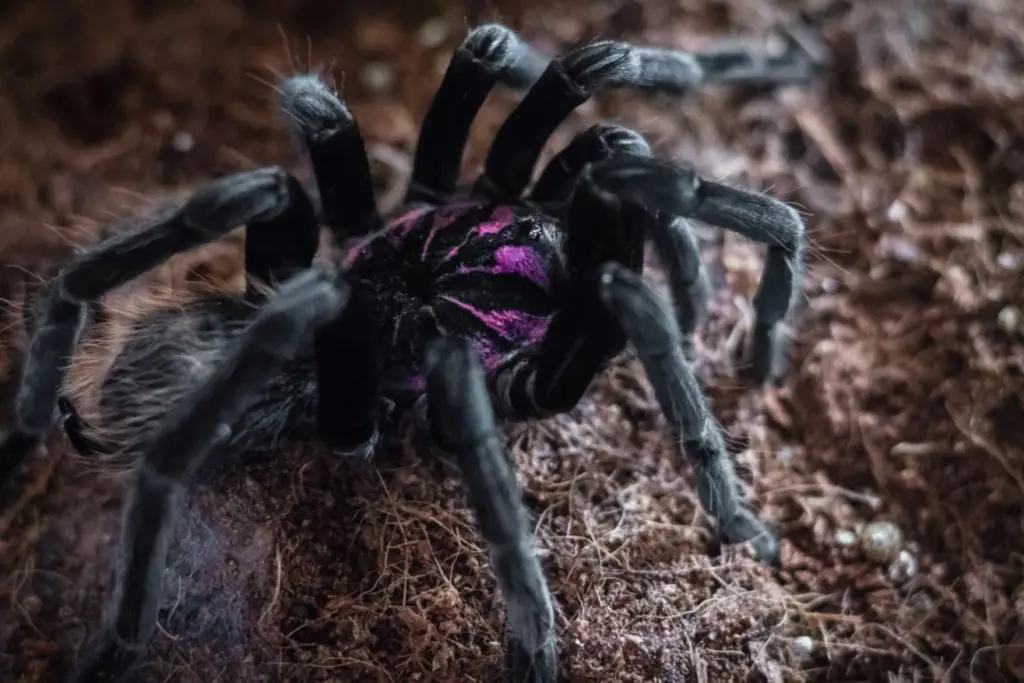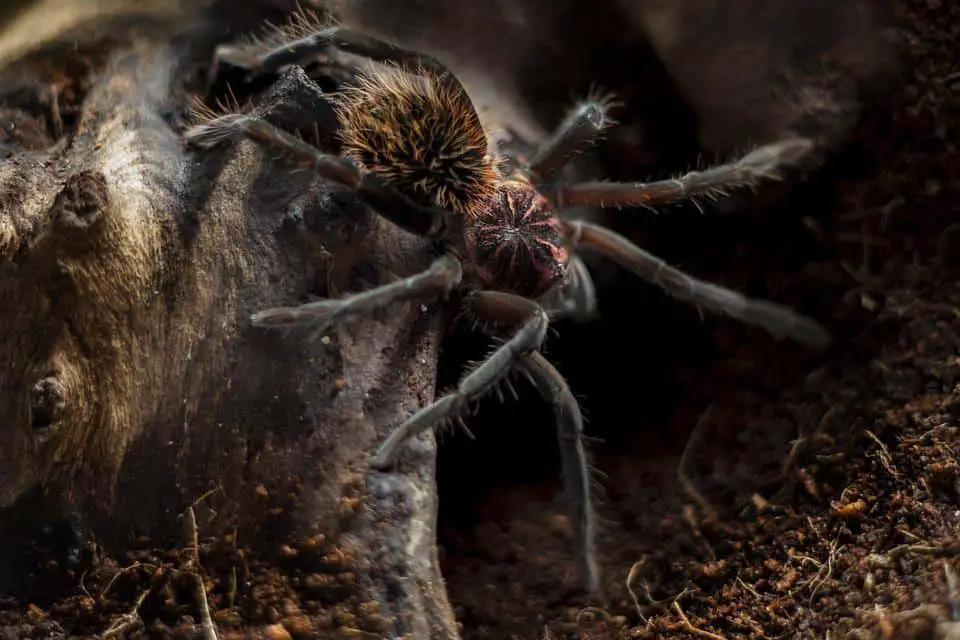The Colombian Lesserblack Tarantula (Xenesthis immanis) is a terrestrial New World spider that’s native to Colombia, Venezuela, and Ecuador. They’re highly desired among hobbyists due to their impressive size and eye-catching coloration.
If the Colombian Lesserblack has caught your eye and you’re considering whether it’ll be a good addition to your collection you have come to the right place. Today, we’ll tell you everything you need to know about these beautiful spiders.

Colombian Lesserblack Tarantula Care Sheet
| Species Name | Xenesthis immanis |
| Family Name | Theraphosidae |
| Common Names | Colombian Lesserblack Tarantula |
| Category | New World |
| Type | Terrestrial |
| Native Location | Colombia |
| Body Length | 2.75 to 3.5 inches (7 – 9 cm) |
| Leg Span | 7.5 to 8.5 inches (19 – 22 cm) |
| Growth Speed | Fast |
| Urticating Hairs | Yes, type I. Males type I & III |
| Social | Solitary |
| Diet | Insects: primarily crickets and roaches. Small rodents/lizards |
| Temperature | 75 to 80 degrees °F |
| Humidity | 75 to 85% |
| Lifespan | Female: 12 to 15 years / Male: 3 to 4 years |
| Experience required | Intermediate |
| Minimum tank size | 16L”x12W”x14H” |
Colombian Lesserblack Tarantula Overview
The Xenesthis immanis, more commonly known in the hobby as the Colombian Lesserblack Tarantula is an opportunistic borrower that lives on the forest floors in several South American countries.
They create burrows under rocks, roots, or other things they find in the forests. They line the burrows they live in with webs to help them hunt. They eat any insect that’s small enough for them to ambush, but they’re also capable of eating smaller mammals or lizards.
In the wild, these spiders have an interesting relationship with the dotted humming frog. The tarantula allows the frog to stay in its burrow where the frog protects the spider’s eggs from ants and the tarantula keeps the frog safe from predators.
Appearance & Variations

The Colombian Lesserblack Tarantula has a mostly black coloration but they have stunning pink markings on their carapace which give them a very eye-catching look. They also have colorful setae which are located on their abdomen.
These species are dimorphic, with males being much thinner than females. Females are much heavier and have bigger abdomens. Their leg span is about the same, but males have thinner legs, giving them a more lanky appearance.
Males might be smaller, but they make up for it by being much more colorful than their female counterparts.
These spiders can grow quite large, topping out at a leg span of 8.5 inches.
Price
The Colombian Lesserblack Tarantula is a relatively expensive species. Slings and juveniles typically cost around $100 to $200. (sub)adult males cost $200 to $250. (sub)adult females are the most expensive and can cost up to $500.
Females are more expensive because they can live up to 4 times as long as males, making them better value.
Temperament & Behavior
The Colombian Lesserblack Tarantula is a shy spider.
They’re easy to scare and when startled will try to run away while kicking the urticating hairs from their abdomen.
Be careful when they do this because these hairs can cause irritation and do actual damage if they end up in your eye, nose, or mouth.
They’re not very defensive and do not often put up a threat posture. They’re also not likely to bite, if by some miracle you do end up getting bitten, their venom is not too potent and should not cause any problems to healthy adults without allergies.
Nevertheless, bites should of course be avoided because they have sharp fangs that can be quite painful, even if their venom is weak.
They’re nocturnal spiders that tend to spend most of the day in their burrows while sitting at the entrance of their burrow at night waiting for prey to pass by.
Because they tend to spend a lot of time in their burrow you might not see them out in the open as much as you’d like, but they’re by no means a “pet hole” like some other species either.
Handling
I recommend against handling this species because of its shy nature. They’re very easily started which can result in them running off your hand. If they fall, they can rupture their abdomen which can be fatal for them.
If you do decide to handle them, make sure that you do it safely for both you and the spider.
Caring for a Colombian Lesserblack Tarantula
Tank Setup
The Colombian Lesserblack Tarantula is a terrestrial opportunistic burrow so they need an enclosure that prioritizes horizontal over vertical space because they do not climb.
A decent minimum tank size to buy for an adult is 16 inches long, 12 inches wide, and 14 inches high. This will give them plenty of space.
If you have slings or juveniles, they can have a smaller enclosure. As long as you give them surface space that’s at least 3 times as big as their leg span, they will be comfortable. Do make sure to rehouse them to larger enclosures as they grow.
Since the Colombian Lesserblack is an opportunistic borrower, you should provide them with a starting burrow, they will move in there and start creating their burrow in the soil. To do this, get a piece of cork bark or anything else you want to use as their starting burrow and place it halfway into the substrate, like this.
If you want, you can put the cork bark near the side of the enclosure, this increases the chance that they create their burrow near the glass, which makes it possible for you to see what’s going on in their home.
To finish their tank, give them a couple of rocks and artificial plants. You can also choose to create a bioactive enclosure, but this is quite tough to do, especially if you’ve never done it before.
Adorning their tank with rocks and foliage not only makes it look prettier, it also increases the chance of your spider venturing outside of its burrow.
Substrate
Substrate is quite important for this opportunistic borrower. Provide them with a layer of substrate that’s at least as deep as their leg span. So, if you have a 7″ Lesserblack, give them a layer of substrate that’s at least 7 inches deep. This will provide them with enough substrate to burrow.
Materials to use as substrate include vermiculite, coconut fiber, peat moss, and topsoil. You can also create a mixture of these and it’ll work swimmingly.
Try to keep the substrate relatively moist. Do not make it swampy, but it should have some moisture for your spider to be comfortable.
Temperature & humidity
Colombian Lesserblack Tarantulas are used to a climate where the temperatures range from 60 to 94 degrees °F, so they can bear these temperatures. However, in captivity, we have more control over what temperature we keep them in, and they seem to thrive in a temperature range between 75 and 80 degrees °F.
Humidity-wise, try to keep the relative humidity at 75 to 85%.
To keep the humidity it’s important that you keep the substrate moist. Another way to increase the humidity is to use a larger water bowl. The evaporation will help to increase moisture.
While humidity is important for these spiders, high humidity does increase the chance of mold or bacterial growth. To reduce the chance of this, try to give them enough ventilation in their enclosure and remove uneaten food in a timely matter.
Social
Colombian Lesserblack tarantulas can not live communally with other members of their species. There have been accounts of them living together with the dotted humming frog in the wild, but they only do this because it’s mutually beneficial. The frog helps keep the spider’s egg safe, while the spider keeps the frog safe from predators.
They do not derive any benefits from living with other spiders. In fact, it’s the opposite because they will feel like they have to compete for food, which can result in fights and cannibalism.
In the wild, they only meet when they’re going to breed, in captivity, it should be the same.
Always house your Colombian Lesserblack Tarantula in a solitary enclosure to keep them safe.
Molting
Your Colombian Lesserblack Tarantula will molt frequently because they’re a fast-growing species.
Especially when they grow from babies into adults they will experience frequent molts.
Important things to know are that they will refuse to eat while in pre-molt. They should also not be fed for several days after they’ve completed a molt because their fangs are weak at that point. They need time for their fangs to harden before they can use them to take down prey.
Diet & Feeding
Colombian Lesserblack Tarantulas have an aggressive feeding response. They take down their prey with a ferocious attack that is exciting to see.
Slings should be fed cricket legs or flightless fruit flies. Do not try to feed them insects that are too large. Colombian Lesserblack slings are relatively large compared to slings of other species, but they’re not capable of taking down large insects yet.
Juveniles can start eating live prey, but still, keep the prey you feed them small. Baby roaches and small crickets are good options.
Sub-adults can start eating quite a bit amount. Feed them around 7 adult crickets or 2 adult roaches every 7 to 10 days. They can also eat mealworms, superworms, and other insects from time to time.
Keep in mind though, that not all individuals should have equal amounts. Some specimens get larger or are more active and should eat more, while others are smaller and should eat less.
To figure out what’s the right amount for your spider you can monitor the size of its abdomen. If it’s growing very rapidly you’re probably feeding them too much, if it’s shrinking, you’re probably underfeeding them.
Feed them only captive-bred insects, as wild-caught insects can contain parasites.
As for hydration, slings drink droplets and larger spiders will drink from a water bowl.
Lifespan & Health
Colombian Lesserblack Tarantula females have a lifespan of 12 to 15 years. Males live much shorter and don’t often live beyond 3 to 4 years.
To keep your spider healthy, make sure to keep their enclosure clean, remove uneaten food, have ventilation in their enclosure, and make sure to avoid falls.
Xenesthis immanis Facts
- The Colombian Lesserblack Tarantula was first described in 1875 by Ausserer.
- The Xenesthis genus often gets confused with the Pamphobeteus genus.
- They used to be known as the Lasiodora immanis, then the Xenesthis colombiana, until finally being named the Xenesthis immanis in 1901.
Final words
The Colombian Lesserblack is a stunning black tarantula with a remarkable purple pattern on its carapace. This unique color pattern in combination with the species’ large size has made many people very interested in adding one of these beautiful spiders to their collection.
While they’re not particularly defensive, they are relatively shy and quick to kick their hairs. Because of this, they’re more suitable for people who have at least intermediate experience caring for large spiders. If you’re an absolute beginner, I recommend getting your feet wet with some of the more docile species like the Antilles Pink Toe or the Arizona Blonde.
However, if this is not your first spider, it’s definitely one that you should consider adding to your collection!
- How Long Do American Eskimo Dogs Live? Important Factors and Care Tips - September 29, 2023
- Do American Bulldogs Need Grooming? Essential Tips and Care Guidelines - September 29, 2023
- Do Bengal Cats Enjoy Playing? Essential Tips for Keeping Them Active - September 29, 2023